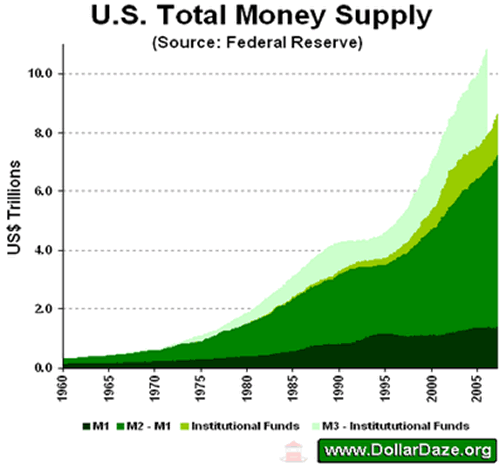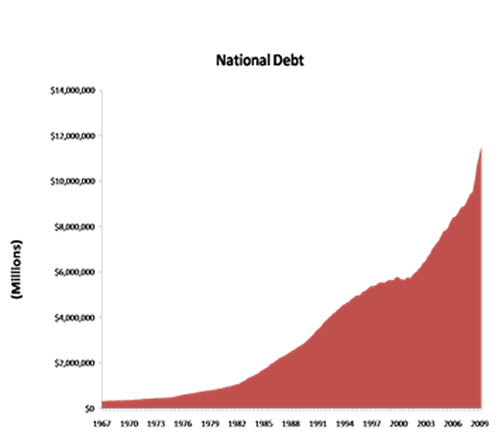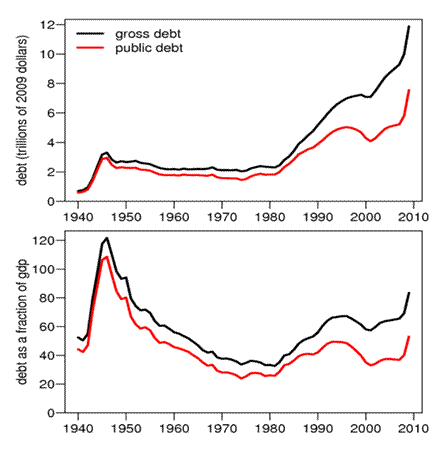Ellen Brown Response to Gary North: QE2 IS the Populist Solution
Economics / Quantitative Easing Nov 25, 2010 - 07:02 AM GMTBy: Ellen_Brown
 Gary North, who purports to be an expert on the errors in my book “Web of Debt,” has evidently not actually read it. In an article posted on the Market Oracle on November 23, he says that in calling QE2 (the Fed’s new quantitative easing program) a “bold precedent,” I have switched sides. He apparently missed the entire chapter I wrote on this subject, first published in “Web of Debt” in 2007, saying exactly what I am saying now.
Gary North, who purports to be an expert on the errors in my book “Web of Debt,” has evidently not actually read it. In an article posted on the Market Oracle on November 23, he says that in calling QE2 (the Fed’s new quantitative easing program) a “bold precedent,” I have switched sides. He apparently missed the entire chapter I wrote on this subject, first published in “Web of Debt” in 2007, saying exactly what I am saying now.
The Federal Reserve is finally using its quantitative easing tool to good purpose, and I’m endorsing that, not just for our central bank but for any central bank anywhere that would be so bold. We are trapped in a web of debt devised by an international banking cartel that has hoodwinked us into believing that we have no recourse but to use money created by their banks as loans. We do have recourse. Money today is simply a legal agreement, an acknowledgment of services performed and debt owed. Every country can and should issue its own money and its own national credit. This would NOT inflate prices, for reasons I have explained again and again. If “money” originates as a receipt for goods and services delivered to the government -- rather than in speculative leveraging by banks not attached to real productivity -- supply and demand will increase together, and prices will remain stable. If the money supply increases beyond GDP, the excess can be taxed or otherwise drawn back to the government.
North writes:
Ellen Brown initially stood with the Greenbackers in their call to end the Federal Reserve. . . . She now says that the FED is on the government's side. "It is the Fed funding the government virtually interest-free, allowing the government to do what it needs to do without driving up the interest bill on the federal debt – an interest bill that need not have existed in the first place." . . .
If she tries to defend herself by saying, "This is consistent with what I have always said," then she is dumber than dirt, or else she thinks her followers are dumber than dirt. If she says, "Yes, I switched. So what?" then she is just another lawyer. . . .
She never had a clue about economic theory or monetary theory. She has therefore switched sides with ease – we might call this intellectual quantitative easing.
Her only hope now is to insist that she never meant anything like this. "No, no, no, I meant something completely different. It's all a big misunderstanding." A lawyer who can't make herself clear needs to find another career – maybe as an economic guru.
I have not switched sides, as anyone who had actually read my book “Web of Debt” would know. Chapter 40, which is all about Ben Bernanke’s helicopter money, says in part (again this was first published in 2007):
[I]n a speech he delivered when he had to be less cautious about his utterances, Dr. Bernanke advocated what appeared to be a modern-day version of Lincoln’s Greenback solution: instead of filling the balloon with more debt, it could be filled with money issued debt-free by the government.
The speech was made in Washington in 2002 and was titled “Deflation: Making Sure ‘It’ Doesn’t Happen Here.” Dr. Bernanke stated that the Fed would not be “out of ammunition” to counteract deflation just because the federal funds rate had fallen to 0 percent. Lowering interest rates was not the only way to get new money into the economy. He said, “the U.S. government has a technology, called a printing press (or, today, its electronic equivalent), that allows it to produce as many U.S. dollars as it wishes at essentially no cost.”
He added, “One important concern in practice is that calibrating the economic effects of nonstandard means of injecting money may be difficult, given our relative lack of experience with such policies.”2 If the government was inexperienced with the policies, they were not the usual “open market operations,” in which the government prints bonds, the Fed prints dollars, and they swap stacks, leaving the government in debt for money created by the Fed. Dr. Bernanke said that the government could print money, and that it could do this at essentially no cost. The implication was that the government could create money without paying interest, and without having to pay it back to the Fed or the banks.
Later in the speech he said, “A money-financed tax cut is essentially equivalent to Milton Friedman’s famous ‘helicopter drop’ of money.” Dropping money from helicopters was Professor Friedman’s hypothetical cure for deflation. The “money-financed tax cut” recommended by Dr. Bernanke was evidently one in which taxes would be replaced with money that was simply printed up by the government and spent into the economy.
QE2 is not quite replacing taxes with money printed up by the government, but as I wrote in the article criticized by Mr. North, in our current system it is the functional equivalent and the next best thing. The Fed is funding the federal deficit by buying long-term government bonds with money created with a computer keystroke, and the Fed rebates its profits to the government after deducting its costs, so this funding is nearly interest-free. These bonds never have to be paid back, because the federal debt is never paid back. An interest-free debt rolled over indefinitely is the functional equivalent of debt-free, government-issued money.
As Dick Cheney famously said, “Deficits don’t matter.” The federal debt not only never DOES get paid back but it CAN’T be paid back under our current debt-based monetary regime. This is because, in some sense, it IS our money supply. As I’ve explained in another article I’m writing now:
Virtually all money today originates as debt, and private debts eventually get repaid, so somebody has to be in “permanent” debt to maintain a stable money supply. The federal debt serves this role. (Compare charts below.) The federal debt has been the basis of the U.S. money supply ever since the Civil War, when the National Banking Act authorized private banks to issue their own banknotes backed by government bonds deposited with the U.S. Treasury.


To meet the demands of an expanding economy, the money supply must be able to expand; and when the money supply is created as a debt (as it is today), that means the federal debt must be able to expand. This was confirmed by Marriner Eccles, Governor of the Federal Reserve Board, in hearings before the House Committee on Banking and Currency in 1941. Representative Wright Patman asked Eccles how the Federal Reserve got the money to buy government bonds.
“We created it,” Eccles replied.
“Out of what?”
“Out of the right to issue credit money.”
“And there is nothing behind it, is there, except our government’s credit?”
“That is what our money system is,” Eccles replied. “If there were no debts in our money system, there wouldn’t be any money.”
That explains why the federal debt never gets paid off but just continues to grow. The federal debt hasn’t been paid off since the presidency of Andrew Jackson nearly two centuries ago. On Jan. 8, 1835, six years into Jackson's presidency, the debt actually reached zero. According to the Bureau of Public Debt, this officially lasted one day. Not long after, America plunged into a depression. By 1838, the debt was $3.3 million. By the end of the Civil War, America owed $2.7 billion.
Economist John Kenneth Galbraith wrote in 1975:
In numerous years following the [civil] war, the Federal Government ran a heavy surplus. [But] it could not pay off its debt, retire its securities, because to do so meant there would be no bonds to back the national bank notes. To pay off the debt was to destroy the money supply.
In all but five fiscal years since 1961 (1969 and 1998 through 2001), the U.S. government has actually exceeded its projected budget, adding to the national debt. The debt soared to record proportions during World War II. By the end of the war, the U.S. debt was more than 100 percent of GDP.
This obviously did not hurt the economy. The productivity generated by record government spending during World War II created the infrastructure that allowed the country to dominate industry globally for the next half century. We are seeing the same sort of rapid infrastructure development today in China, which may well fill the role of world productivity leader in this century.
The U.S. debt incurred during World War II was never paid off but just continued to rise. This too did not hurt the economy; the debt just became a smaller and smaller percentage of GDP as the economy expanded.

Indeed, that is the secret to adding “money” to the system without inflating prices: it needs to be used for productive rather than speculative purposes. Inflation results when “demand” (money) exceeds “supply” (goods and services). When money is used to “make money” (speculation) without adding to goods and services, prices are driven up. When the money is used to produce goods and services, supply and demand increase together and prices remain stable.
The issue posed by QE2 is the sovereign right of a country to print its own money, debt-free and interest-free. Whether conservative, liberal, or populist, any true patriot would support that; and we should support it not just for the United States but for all countries.
Ellen Brown developed her research skills as an attorney practicing civil litigation in Los Angeles. In Web of Debt, her latest book, she turns those skills to an analysis of the Federal Reserve and “the money trust.” She shows how this private cartel has usurped the power to create money from the people themselves, and how we the people can get it back. Her earlier books focused on the pharmaceutical cartel that gets its power from “the money trust.” Her eleven books include Forbidden Medicine, Nature’s Pharmacy (co-authored with Dr. Lynne Walker), and The Key to Ultimate Health (co-authored with Dr. Richard Hansen). Her websites are www.webofdebt.com and www.ellenbrown.com.
© Copyright Ellen Brown 2010 - All Rights Reserved
Disclaimer: The above is a matter of opinion provided for general information purposes only and is not intended as investment advice. Information and analysis above are derived from sources and utilising methods believed to be reliable, but we cannot accept responsibility for any losses you may incur as a result of this analysis. Individuals should consult with their personal financial advisors.
© 2005-2022 http://www.MarketOracle.co.uk - The Market Oracle is a FREE Daily Financial Markets Analysis & Forecasting online publication.



